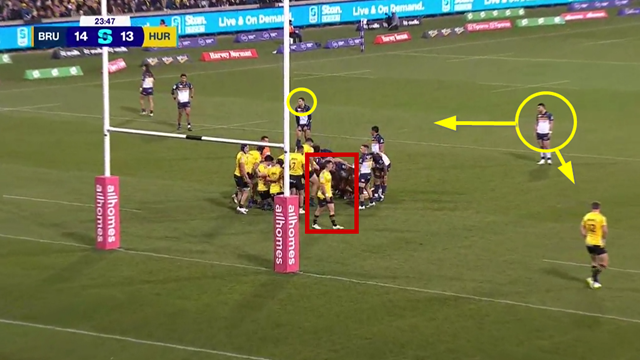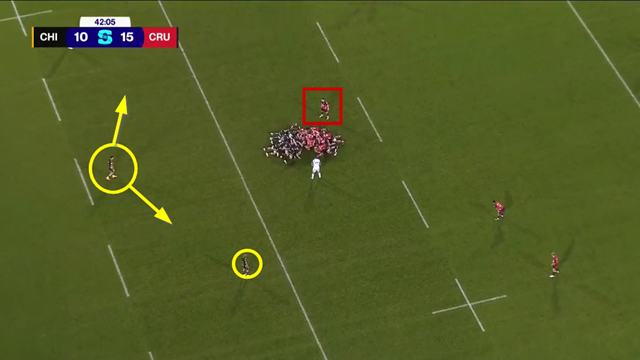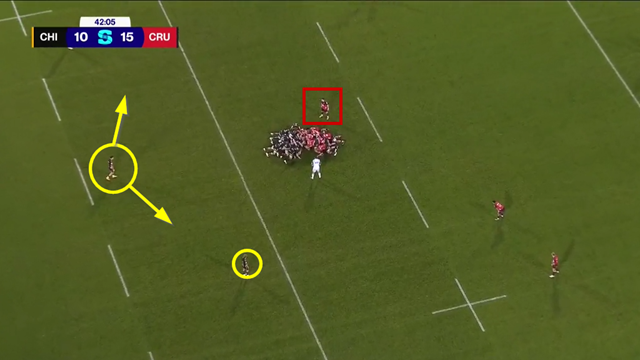Law changes frequently have repercussions, or send out impact ripples well beyond the original intention – for better or for worse. The Super Rugby Pacific law-trial governing the actions of the defensive scrum-half at the set-piece has been exclusively positive in its effect.
Let’s start with a quick reminder of the relevant 2023 trial:
10) Defending #9 not being allowed past the mid-line of the scrum [modification Law 19:30].
Once play in the scrum begins, the scrum-half of the team not in possession:
a) remains on that team’s side of the middle line within 1m of the scrum, or
b) permanently retires to a point on the offside line either at that team’s hindmost foot, or
c) permanently retires at least five metres behind the hindmost foot.>/p>
It was one of a host of changes designed to make the game both quicker and cleaner to watch [and referee], along with a batch of new time restrictions on the formation of set-pieces, water breaks and kicks at goal.
As SRP Tournament Director Matt Barlow commented at their announcement,
“We want Super Rugby Pacific to be the most entertaining, innovative and fastest professional rugby competition in the world.
“We’ve listened to our fans and taken steps to reduce stoppages and video replays, increase flow and maintain the integrity of the competition and the safety of players in regard to yellow and red cards.
“Players, coaches and referees are excited about these innovations, and we believe they will create a better fan experience both at the game and for those watching on television.”
I have already written two pieces illustrating how the new law regarding positioning of the defensive #9 has revived the positive use of scrums via quick-hitting pick-ups at the base by a #8 forward – as opposed to simply scrumming for a penalty and starting from lineout why-teams-are-feeling-the-need-the-need-for-speed-at-the-scrum-base and why-teams-are-feeling-the-need-the-need-for-speed-at-the-scrum-base-part-2
The law-change has also changed how the backs attack and defend. With the defensive #9 now unable to chase around to the base and committed to retiring behind the last foot of the scrum, a game of a chess – or more accurately a gimlet-eyed ‘Mexican stand-off’ – has developed between the attacking #15 and the defending scrum-half.
This applies especially at midfield scrums when both players are free to go in either direction as the ‘spare’ players on both attack and defence. The masked positioning of the attacking full-back directly behind the scrum has given the defensive side problems which it has been unable to solve in some big knockout matches.
Let’s take a look at the simplest example first, from the SRP quarter-final between the Brumbies and the Hurricanes:

The Brumbies #10 Jack Debreczeni (in the small circle) is already committed to the right-hand side, so the principal concern for the Hurricanes D is the intention of Brumbies’ full-back Tom Wright, positioned behind the set-piece. The responsibility for ‘spying’ on Wright falls on Canes’ #9 Cam Roigard (in the red rectangle).
Wright disguises his direction of travel until the very last moment, leaving Roigard flat-footed, and therefore passive on D:
Roigard’s passivity is infectious – the man outside him, Jordie Barrett cannot move until the scrum-half shifts first. A nice double-pump by Wright finishes the job, drawing Jordie’s eyes towards the passer for long enough to give Len Ikitau a clear run to the line.
A more complex example occurred in the SRP final between the Chiefs and the Crusaders in Hamilton:

The Chiefs’ nominal first receiver Damian McKenzie is in the small circle on the right, but the key attacker is #15 Shaun Stevenson – hidden behind the scrum but monitored by Crusaders’ #8 Mitch Drummond (in the red square).
The target area for the attacking incision is two passes wider than it was in the first instance, and the main idea is to set up Stevenson in a foot-race with Drummond, coming from the other side of the scrum. The in-pass from #13 Alex Nankivell leaves Drummond a couple of steps short of preventing the half-break by Stevenson, and the killing money-ball out to Emoni Narawa out on the right wing:
The overhead shot makes the design of the play crystal clear. It is a race to the attacking hole between Stevenson and Drummond, and the Chiefs’ full-back wins it in style.
Summary
The new law-trial focused on the defensive play of the #9 at scrums may have been issued last on the list of law changes, but it was no afterthought. It has had a notably positive impact on Super Rugby Pacific 2023, encouraging the attacking side to launch plays both off the base through their #8, and into the wider channels via their hidden full-back. It can only be a good move for the game as a whole.












.jpg)

.jpg)







